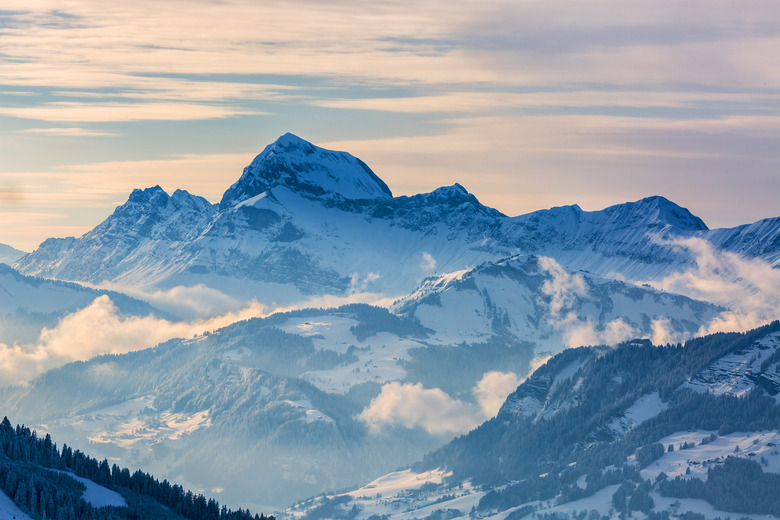Landforms Caused By Plate Tectonics
The activity that occurs when two tectonic plates interact with each other can have a major impact on the landscape of the Earth, needless to say. Although the process can take millions of years, the landforms created by plate tectonics offer some of the most impressive natural land features in the world.
TL;DR (Too Long; Didn't Read)
Tectonic activity accounts for some of the most dramatic and large-scale landforms on Planet Earth. Collisions of two plates may create everything from fold mountains to oceanic trenches; divergent plates come marked by mid-ocean ridges.
Fold Mountains
Fold Mountains
The compressional forces stemming from a convergent plate boundary, where two plates collide with one another, can create fold mountains. This may involve the collision of two continental plates or a continental plate and oceanic plate, forcing sedimentary rocks upwards into a series of folds. Fold mountains usually form along the edges of continents, because these margins tend to accumulate the greatest sedimentary deposits. When tectonic plates collide, layers of accumulated rock crumple and fold. Fold mountains 100 million years old or less, such as the Himalayas, are known as young fold mountains and account for the planet's highest, most impressive ranges. Old fold mountains, which typically formed 250 million years ago or more, mark formerly active plate boundaries and tend to be significantly lower and more eroded; examples include the Appalachians and Urals.
Ocean Trenches
Ocean Trenches
Ocean trenches form at two kinds of convergent plate boundaries: where a continental and oceanic plate converge, or where two oceanic plates converge. Oceanic plates are denser than continental plates and so plunge beneath them, or "subducts"; at an oceanic/oceanic boundary, whichever plate is denser – the older, cooler plate – subducts beneath the other. In both cases, the subduction forms an undersea trench. These trenches are long, narrow valleys and include the deepest areas of the ocean. The deepest ocean trench is the Marianas Trench, reaching a depth of almost 36,000 feet below sea level.
Island Arcs
Island Arcs
The subduction process that occurs when an oceanic plate converges with another oceanic plate can lead to volcanoes being formed paralleling the trench. The volcanic debris and lava build up on the ocean floor over millions of years and eventually results in a formerly submarine volcano rising above sea level to create an island. A curved chain of these volcanoes, known as an island arc, usually occurs in these cases. The magma that forms these arcs derives from partial melting around the descending plate or the overlying oceanic lithosphere.
Ocean Ridges
Ocean Ridges
At divergent boundaries, plates move away from each other, creating a new crust as magma is pushed up from the mantle. Mid-ocean ridges result from volcanic swelling and eruptions along the divergent boundary. The movement of the tectonic plates transports the newly formed crust away from the crest of the ridge in both directions. The Mid-Atlantic Ridge serves as a well-known example. The Mid-Atlantic Ridge spreads at an average rate of 2.5 centimeters each year, having resulted in thousands of kilometers of plate movement and creating the mountains that exist today over the course of millions of years.
Cite This Article
MLA
Ames, Hayley. "Landforms Caused By Plate Tectonics" sciencing.com, https://www.sciencing.com/landforms-caused-plate-tectonics-8039880/. 20 April 2018.
APA
Ames, Hayley. (2018, April 20). Landforms Caused By Plate Tectonics. sciencing.com. Retrieved from https://www.sciencing.com/landforms-caused-plate-tectonics-8039880/
Chicago
Ames, Hayley. Landforms Caused By Plate Tectonics last modified August 30, 2022. https://www.sciencing.com/landforms-caused-plate-tectonics-8039880/
